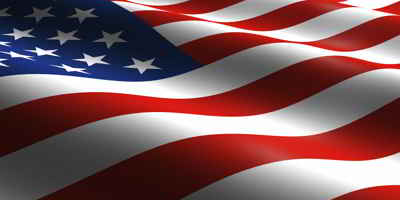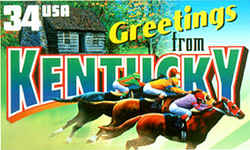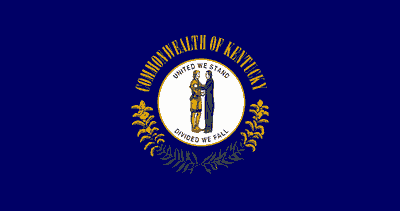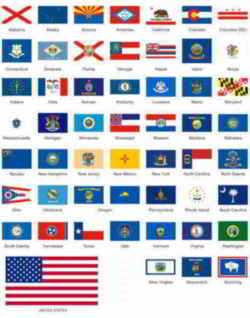

Kentucky Symbols
Kentucky State
Flag
Adopted in March 26, 1928; 1961
Kentucky's State flag was authorized by an Act of the General Assembly on March 26, 1918. The 1918 act specified that the flag be made of
"...navy blue silk or bunting, with the seal of the Commonwealth of Kentucky encircled by a wreath of goldenrod, embroidered, printed or stamped on the center thereof."
Dimensions of the flag were not specified but were allowed to vary.
Kentucky's State Flag was authorized in 1918, but the design of the flag was not approved until 1928. The flag was designed by Jesse Cox Burgess, an art teacher in Frankfort, the state capital. The flag was adopted by the Kentucky General Assembly on March 26, 1918, and finalized the process by including a drawing in the statutes on 1928.
The Kentucky State Flag
It took ten years of decision for an official design to be obtained. In 1918 it was a matter of record that Kentucky should have a State Flag, but specifications could not be met to the satisfaction of all concerned until 1928. The General Assembly gave its final approval then, and incorporated a drawing of the flag into the Statutes - the first time an illustration became part of Kentucky's laws. The flag should be made of silk or poplin, navy blue in color, imprinted in gold. The imprint in the center of the flag is a reproduction of the state seal. Dimensions of the flag were not specified.
The first official state flag was made in early 1920 for a ceremony at Camp Zachary Taylor, in Louisville. The flag had been hastily put together, with little artistic design and was barely passable as the flag of the Commonwealth. Following the ceremony, the flag was sent to Credo Harris for creative improvements. A committee was formed, and three designs were agreed upon. These three were then combined into one design, which was to be sent to the Governor for approval. The design was forgotten or lost during its bureaucratic shuffle, and nothing ever resulted. After a long period of time, the 1920 flag was finally returned to Frankfort, placed in the custody of the Kentucky Historical Society.
During the administration of Governor Flem D. Sampson, an official flag was needed for another military ceremony. Jouett Cannon, then secretary of the Kentucky Historical Society, commissioned Jessie Cox Burgess, an art teacher in the Frankfort city school system, to come up with a design. Burgess' design consisted of ink sketches of the state's seal, embellished with goldenrod branches, done in oil paints, encircling it. Three flags were then made in Philadelphia; only two of these found their way to Frankfort, one being lost during a Chicago ceremony needing a flag representing Kentucky.
It was not until 1961 that the Kentucky Legislature officiated the design, colors, and specifications for the state's flag. Major Taylor L. Davidson, while serving the Adjutant General, speer-headed the project by researching the history and early designs of the state flag. Harold Collins, artist, was then asked to produce three color designs to be presented to Governor Bert Combs for a decision. Once the design was chosen, a template was made, and then detailed specifications were transcribed by Major Davidson into a new bill. The bill (KRS 2.030), the first and only bill with illustrations included in to the Kentucky statute, was passed into law during the 1962 session.
Design and Symbols of the Kntucky State Flag
The flag consists of the Commonwealth's seal on a navy blue field, surrounded by the words "Commonwealth of Kentucky" above and sprigs of goldenrod, the state flower, below. The seal depicts a pioneer and a statesman embracing. Popular belief claims that the buckskin-clad man on the left is Daniel Boone, who was largely responsible for the exploration of Kentucky, and the man in the suit on the right is Henry Clay, Kentucky's most famous statesman. However, the official explanation is that the men represent all frontiersmen and statesmen, rather than any specific persons. The state motto: "United We Stand, Divided We Fall" circles them. The motto comes from the lyrics of "The Liberty Song", a patriotic song from the American Revolution.
Kentucky's Flags Before 1918
Although Kentucky didn't have an official state flag until 1918, the state has had many flags representing various affiliations and countries flying over the bluegrass. During the 1600's, Spaniards on their way to northern settlements near Lake Onondaga, New York, camped throughout Kentucky. Unfortunately, they were all either burned or tomahawked before reaching their destination.
During the early 1700's, explorers LaSalle, Marquette and Iberville brought the French monarchy's fleur-de-lis to the southwestern portion of Kentucky. France held a portion of the state until the French and Indian War, when the land was ceded to Great Britain as part of the Proclamation of 1763, then later the Quebec Act of 1774.
The "Union Jack" of Great Britain flew over the Commonwealth until Revolutionary War. Once the Declaration of Independence was signed, Kentucky briefly adopted the flag of Virginia. (Kentucky, at the time, was not a state of the Union, but rather a Commonwealth of Virginia.) But as war developed, forts in Harrodsburg, Lexington and Louisville took the flag of the United States, the flag of thirteen stars and thirteen stripes; the rest of the state soon followed.
After the Revolutionary War, the state again briefly adopted the flag of Virginia as its flag. When Kentucky was admitted to the Union in 1792, the flag signifying its new statehood status, the flag of fifteen stars and fifteen stripes, was adopted. As states were added to the Union and the US flag modified within the next few decades, Kentucky retained the national flag as its unofficial flag.
During the Civil War, Kentucky had both Confederate and Union flags flying over it. Although Kentucky never seceded from the Union, from the beginning of the war until late 1863 the Confederate flag was most prominently used in the state as well as a white battle flag with a smaller version of the "Stars and Bars" in the lefthand corner. General John Hunt Morgan, with his infamous raids from July 1861 to July 1863, established Confederate occupancy throughout much of the southern and central portions of the state until his and his division's capture by Federal troops near Lisbon, Ohio in July of 1863. Morgan escaped on November 26, 1863. Placed in command in East Tennessee and southwestern Virginia the next year, he was surprised and killed at Greeneville, Tennessee, on September 4, 1864.
After the Confederacy lost its strongholds in Northern Tennessee and Southern Kentucky, the Union flag regained prominence. From the end of the Civil War until World War I, Kentucky retained the flag of the Union as its unofficial state flag. An official state flag depicting the state's seal encircled with goldenrod was adopted in 1918.
Kentucky Flag Law
Kentucky Code, Title 1, Chapter 4.
TITLE I - SOVEREIGNTY AND JURISDICTION OF THE COMMONWEALTH.
CHAPTER 2 - CITIZENSHIP, EMBLEMS, HOLIDAYS, AND TIME.
2.030 State flag.
(1) The official state flag of the Commonwealth of Kentucky shall be of navy blue
silk, nylon, wool or cotton bunting, or some other suitable material, with the seal of the
Commonwealth encircled by a wreath, the lower half of which shall be goldenrod in bloom and
the upper half the words "Commonwealth of Kentucky," embroidered, printed, painted,
or stamped on the center thereof. The dimensions of the flag may vary, but the length shall
be one and nine-tenths (1 9/10) times the width and the diameter of the seal and encirclement
shall be approximately two-thirds (2/3) the width of the flag.
(2) The approved official drawings of the state flag shall be permanently retained in the files
of the office of the Secretary of State. All state flags for official use of the Commonwealth
shall conform as to color and design with these official drawings.
(3) The emblem at the head of a flagstaff used to display the flag of the Commonwealth of Kentucky
shall be the Kentucky cardinal in an alert but restful pose, cast in bronze, brass, or other
suitable material.
(4) The flying of the state flag at all state buildings and installations including public
school buildings, National Guard armories, state parks, and other such buildings is considered
proper and is encouraged.
(5) No disrespect should be shown to the flag of the Commonwealth of Kentucky. With the exception
of the flag of the United States of America, the flag of the Commonwealth of Kentucky should
not be dipped to any person or thing. The flag should never touch anything beneath it, such
as the ground, the floor, water, or merchandise. The flag, when it is in such condition that
it is no longer a fitting emblem for display, should be destroyed in a dignified way, preferably
by burning.
Effective: July 15, 2002
History: Amended 2002 Ky. Acts ch. 196, sec. 1, effective July 15, 2002. -
Amended 1962 Ky. Acts ch. 114, secs. 1, 2, 3, and 4, effective June 14, 1962. - Recodified
1942 Ky. Acts ch. 208, sec. 1, effective October 1, 1942, from Ky. Stat. sec. 4618m.
2.035 Pledge of allegiance to state flag.
The following shall be the official pledge of allegiance to the flag of the Commonwealth of
Kentucky: "I pledge allegiance to the Kentucky flag, and to the Sovereign State for which
it stands, one Commonwealth, blessed with diversity, natural wealth, beauty, and grace from
on High."
Effective: July 14, 2000
History: Created 2000 Ky. Acts ch. 206, sec. 1, effective July 14, 2000.

The Flags of the US.





